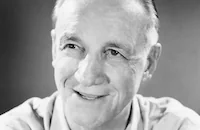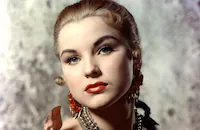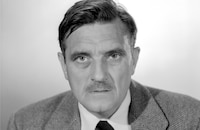Most Dangerous Man Alive

Brief Synopsis
Cast & Crew
Allan Dwan
Ron Randell
Debra Paget
Elaine Stewart
Anthony Caruso
Gregg Palmer
Film Details
Technical Specs

Synopsis
Racketeer Eddie Candell is framed on a murder charge. He escapes from the police and wanders into a blast area where scientists are conducting an experiment in cobalt mutation. He survives the explosion and discovers that his body is now capable of absorbing steel. He then pursues Andy Damon, the rival gangster who not only framed him but also took over both his mob and his moll, Linda Marlow. Damon attempts to kill his old enemy but flees when he learns that Eddie is impervious to bullets. Realizing that his body is slowly turning to steel, Eddie seeks comfort from Carla Angelo, a woman he once befriended. After Damon has fatally wounded Linda, Eddie kills him. He meets his own end when a National Guardsman turns a flamethrower on him and burns his body of steel into powdery dust.

Director

Allan Dwan
Cast

Ron Randell

Debra Paget

Elaine Stewart

Anthony Caruso
Gregg Palmer

Morris Ankrum
Tudor Owen
Steve Mitchell
Joel Donte
Crew

Film Details
Technical Specs

Articles
Most Dangerous Man Alive
When he signed on to direct Most Dangerous Man Alive, Allan Dwan was likewise at the end of an illustrious career that had started at the pioneering Essanay Studios in Chicago. Spending working winters out west (where the desert climate was more conducive to outdoor filming), Dwan eventually headed one of California's first motion picture factories, Flying A Studios. In Hollywood, Dwan was credited with creating the first crane shot (for D.W. Griffiths' Intolerance in 1916), for early experiments with color and sound film, and for shepherded such actors as Douglas Fairbanks, Mary Pickford, Lon Chaney, Lillian and Dorothy Gish, Carole Lombard, Ida Lupino, Rita Hayworth, and Natalie Wood to stardom or continued stardom while providing early work to future directors John Ford and Vincent Sherman and to producers-to-be Mike Frankovich and Joe Pasternak. By the end of his life, Dwan estimated that he had helmed over a thousand films (from shorts to features) - among them Robin Hood (1922) and The Iron Mask (1929) with Fairbanks, Heidi (1937) and Rebecca of Sunnybrook Farm (1938) with Shirley Temple, Sands of Iwo Jima (1949) with John Wayne and Most Dangerous Man Alive, his last.
Most Dangerous Man Alive sprang from an original story titled The Atomic Man by character actor/screenwriter Leo Gordon (John Dillinger to Mickey Rooney's Baby Face Nelson [1957]). Gordon tapped fellow actor-writer Michael Pate (an Australian stage actor who similarly excelled as a Hollywood heavy) to help flesh out the tale of a normal man given extraordinary abilities by exposure to atomic fallout; when Gordon sold his interest in the property, Pate brought in brother-in-law Phillip Rock and retitled the story The Steel Monster. The property was sold to independent producer Benedict Bogeaus, who had already collaborated with Dwan on a number of films, among them The River's Edge (1957), starring Paget and Ray Milland. The crafty Bogeaus brokered a deal with Mexican producers to shoot Most Dangerous Man Alive on the cheap at Churubusco Studios outside Mexico City and went the extra mile of registering the production not as a feature film but as episodes of a proposed TV pilot series in a bid to minimize his costs. The Mexican authorities were not fooled, however, and obliged Bogeaus to hire union men at full cost, resulting in a greatly compressed shooting schedule and a generally skimpy aesthetic.
The logline of Most Dangerous Man Alive resembles a superhero origin tale, melding the backstories of Superman, that extraterrestrial Man of Steel, and Plastic Man, a two-bit thug exposed to a chemical reagent during a warehouse heist. The film boasts a cinematic kinship to such Hollywood horrors as The Walking Dead and The Invisible Ray (both 1936), which sent Boris Karloff into the world on a science-fueled kill spree, as well as to Man Made Monster (1941) and Indestructible Man (1956), in which Lon Chaney, Jr. played prison convicts super-empowered by electricity. Fears of atomic age fallout gave rise to sundry supersized creatures on the silver screen, from the reawakened Rhedosaurus of The Beast from 20,000 Fathoms (1953) to the giant ants of Them! (1954), leaving Bert I. Gordon to put a human face to those fears in The Cyclops (1957), The Amazing Colossal Man (1957), and War of the Colossal Beast (1958) - all of which paved the way for Most Dangerous Man Alive. Dwan's final film also bears a passing resemblance to Raoul Walsh's White Heat (1949), whose figuratively larger-than-life antihero Cody Jarrett shares with Ron Randell's fingered felon Eddie Candell a penchant for Ozymandian proclamations of power and an apocalyptic comeuppance.
by Richard Harland Smith
Sources:
Who the Devil Made It: Conversations with Legendary Film Directors by Peter Bogdanovich (Alfred A. Knopf, 1997)
Keep Watching the Skies: American Science Fiction Movies of the Fifties, The 21st Century Edition by Bill Warren (McFarland and Company, Ltd., 2010)
Michael Pate obituary by Tom Vallance, The Independent September 20, 2008

Most Dangerous Man Alive
Quotes
Trivia
Miscellaneous Notes
Released in United States June 1961
Released in United States Summer June 1961
Wim Wenders payed a kind of hommage to this film with his 1982 production "The State of Things".
b&w
Film was actually shot entirely in Mexico in 1958, but not released in the USA until 1961.
Released in United States June 1961
Released in United States Summer June 1961













